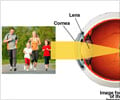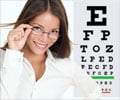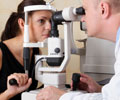Q: Which doctor should I consult for visual problems?
A: You should consult an ophthalmologist for presbyopia or other visual problems.
Q: I have recently acquired bifocals and I am finding it extremely difficult to navigate stairs especially when going down. I feel like I am falling. Why is this so?
A: This is because you are looking at the stairs through the lower reading segment which is meant only for near use. You should bend your head down so as to see the stairs through the upper segment which is for distance use. Then you will not face this problem.
Q: My elderly father is very well adjusted to progressives for all activities except climbing up and down stairs. I’m afraid he may trip and fall. Is there a solution?
A: Unfortunately, very elderly people even though well-adjusted with progressives, are at risk for falls during navigation of stairs. There are two convenient options for this. The first is to switch over to single vision spectacles during this activity alone while using his progressives for all others. This will involve carrying 2 sets of spectacles whenever he goes out. If he doesn’t like this option, then he may use progressives where the intermediate correction is incorporated in the reading segment. This will help in easier stair navigation as well as for intermediate distance activities like computer use and reading labels off grocery shop shelves, as well as short term close reading. He may use a separate glass with single vision correction for prolonged near work with very small print. Either option requires 2 sets of spectacles; in the second, there will be less frequent switching between the two sets.
Q: I was told that use of progressives takes care of vision at all distances and so would be comfortable for computer use as well. However, I spend many hours a day on the computer, and find that raising my head to maintain good vision at this distance is not comfortable for me for long periods of time. Is there a solution for this?
A: In your case, since you spend many hours on the computer, it would be a good idea to have a separated pair of spectacles exclusively for computer use, while using your progressives at all other times. You will notice that with exclusive computer glasses, the image quality is also slightly better and navigating a wide screen is more comfortable without side-to-side distortion.
Q: I have just been fitted with progressives for presbyopia. I find that when I move my head from side to side, there is a swirling effect and I feel there is distortion of the environment. This is making me feel very uncomfortable. I spent so much money on them but now I don’t feel like wearing these glasses.
A: This is very common in people who start using progressives for the first time. When you wear bifocals, there is an image jump when your gaze shifts from the top to the bottom segment. With progressives, there is additional distortion on side-to-side movement. It takes some time to get accustomed to this phenomenon. It helps in the beginning, to consciously point your nose at whichever object you wish to gaze upon. This helps minimize side-to-side distortion. After some time, you will start doing this automatically without your knowledge. To minimize this effect, you can go in for progressives with a wide corridor. Wide corridor progressives are much more expensive than regular ones.
Q: I am 58 years old. I spend many hours at the computer and so use single vision glasses for intermediate distance. However I also need to refer to print material at regular reading distance and I am not able to manage with these computer glasses. I don’t want to use progressives as I don’t like the side-to-side distortion while using the computer. Is there a solution for this?
A: If you do not wish to go for progressives, then you could go in for a bifocal wherein the intermediate distance power is incorporated in the top segment, and the reading power is incorporated in the bottom segment.
Q: I have been using contact lenses for myopia for many years now and I am very comfortable. However now at the age of 42, I am finding near work difficult. I tried multifocal contacts, but I didn’t like them. I don’t have much of near work activities, but reading is difficult.
A: You can continue to wear your contact lenses for distance, and wear additional spectacles exclusively for reading.
Q: I was using glasses for reading for many years. Now I notice that I can read my novels more comfortably without my reading glasses. Why is this so?
A: This phenomenon is referred to as second sight. Initially you required reading glasses like any presbyope would, but now you have developed a short sightedness because of changes in your crystalline lens (nuclear sclerosis). Hence you are able to read without glasses; you will notice that distance vision requires the use of spectacles.
Q: I have been advised monovision contact lenses. I was told that one eye is corrected for distance and the other for near. Will that not strain my eyes if I use only one constantly for a particular distance?
A: No, it will not. However you must keep in mind, that there will be a bit of a compromise with respect to binocularity; that is to say, you must not go for a monovision option if you need good depth perception such as in the use of microscopes, telescopes or situations that require precise assessment of speed or distance of objects.
Q: Are there any disadvantages to multifocal intraocular lenses? I have heard that most intraocular lenses that are implanted after crystalline lens removal are monofocal. Why is not every patient fitted with them if near vision is an expected problem?
A: Multifocal intraocular lenses can be associated with certain unwanted effects such as night halos, glare, loss of contrast sensitivity and difficulty in night driving. The quality of vision is also not as crisp as monofocal lenses, and so they are not for people with exacting visual requirements.














